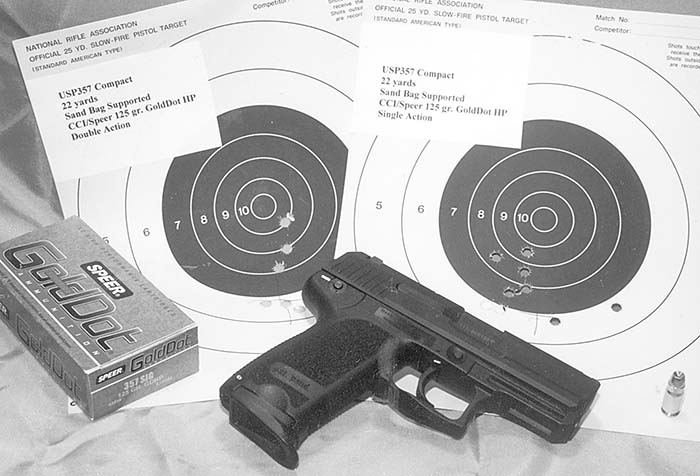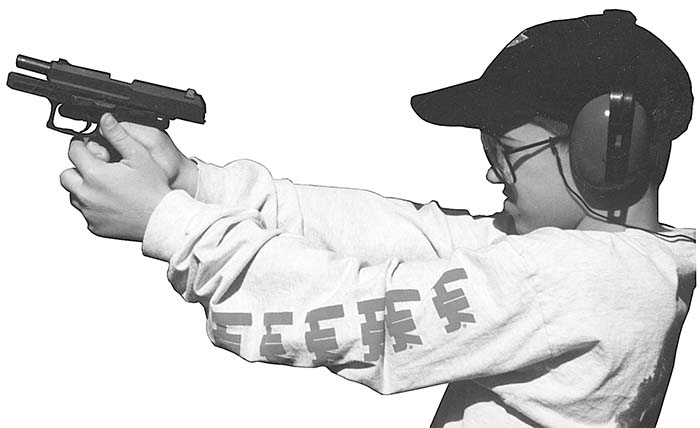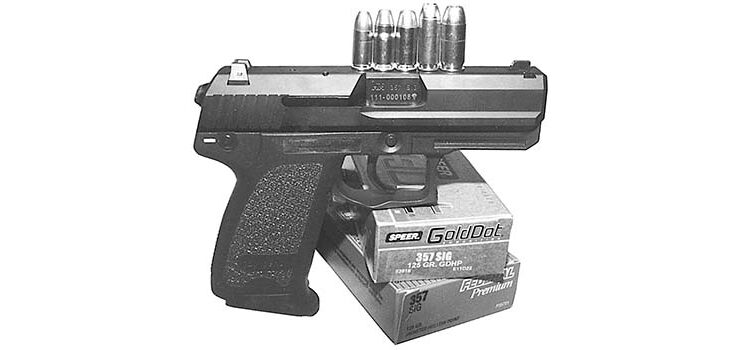By Stephen Gearinger
Few firearm companies today offer the wide range of handgun choices available from, ironically, one of the world’s premier long gun manufacturers, Heckler & Koch. The USP family of semi-automatic pistols offers more models (13) and variants (133) than anyone we can think of, including Glock. The latest model of the USP, soon to be available on dealer’s shelves, is the brand new USP357 Compact model chambered for the increasingly popular .357 SIG cartridge.
Having had extensive experience with the outstanding .40 caliber USP Compact, I expected good things from this new USP iteration. Recently I had the chance to spend some time on the range with one of the very first production samples of the HK USP357 Compact pistol imported by HK for a federal law enforcement bid. After a hard range workout with the little semi-auto, I was quite impressed to say the least, both with the new USP and with the .357 SIG round. The compact size and lightweight (27.5 ounces unloaded) will make this handgun perfect for concealed carry but it is the USP357’s performance on the range that is truly astounding. No pistol in this size class should shoot this well but this one does. Combining the hard-hitting .357 SIG round with such a superior delivery system makes for one serious piece of defensive hardware.

The USP357 is a “caliber cousin” of the .40 S&W USP Compact. The two guns are identical with the exception of the barrel and the caliber markings visible on the slide, barrel locking block and magazine. The specifications for these two little HK compacts are the same, down to the magazine capacity, 10 rounds for civilians, 12 for law enforcement and military personnel. Even the suggested retail price of $685 for the USP357 Compact matches exactly that of its compact .40 S&W predecessor.
The USP357 Compact pistol uses the now common fiber reinforced polymer frame first pioneered by Heckler & Koch in production handguns during 1960s in the HK VP70 pistol. It is interesting to point out that the 9mm HK VP70 offered the advantages of the Glocks of today, i.e. uniform trigger pull for every shot, no manual safety, striker fired, 18-round magazine, durable finish and at a very low unit cost. One might say a Glock before its time. Gaston Glock, incidentally, was reported to have offered unsuccessfully the design of his now famous “safe action” pistol to HK. As the story goes, like others, HK politely turned him down. Wow, what an opportunity missed. Anyway back to the subject of this story.
Like all USP’s this latest model makes use of HK’s modified Browning linkless recoil operating system with mechanical recoil reduction sub-system. The polymer frame is topped off with a one-piece machined steel slide and tough, durable cold hammer forged barrel with conventional lands and grooves rifling. A fast and convenient ambidextrous magazine release is standard as are the molded-in accessory mounting grooves, an innovation first found on the original HK USP40 and now copied by many other pistol makers.

As is the case with almost all USP models, the USP357 Compact can be purchased or converted into any one of nine variants. Variant conversion can be made by any HK factory trained armorer in minutes and with no more than a simple pin punch required to make the change. These variants are simply drop-in, no modification exchanges of the component parts in the frame that control the way in which the pistol can be fired and carried. One model can be any one of the nine variants so the flexibility to change the way in which the USP can be fired and safely carried is at the discretion of the operator.
There are four DA/SA variants, three DAO variants and two variants for the “cocked and locked” diehards among us. Odd numbered variants (1,3,5 and 9) have what HK calls the “control lever” mounted accessibly on the left side of the frame for the right handed shooter. Aptly named as it controls the firing method of the handgun, the USP control lever can be a safety lever, a decocking lever or a combination of both depending on the variant parts present within the pistols frame. Even numbered variants (2,4,6 and 10) have the control lever located on the right side for southpaws. By the time this article goes to print, ambidextrous control levers will be available for both full size and compact models of the USP. Variant 7 is a slick sided DAO variant that functions like a DA revolver firing all shots semi-automatically from the hammer down position. HK’s chart explaining each variant in detail is provided below for clarification.
What is the missing USP variant 8 you ask? HK says it is a special DAO variant, just like variant 7, but with imported tritium night sights from Europe, a mysterious “government test sample” as it has been called. Reportedly, the first USP variant 8’s were in fact .40 S&W samples submitted for testing by the U.S. INS/Border Patrol in 1991. Variant 8’s are not generally available and the few that were imported are considered by some to be collector pieces. That then leaves nine officially recognized USP variants in four calibers, two frame sizes and two slide finishes as well as a few task specific hybrid USP models to choose from.
HK is currently producing the first 500 USP357 Compact pistols available for general retail and law enforcement sale in the U.S. beginning in November 1998. All are to be imported in the ever-popular variant 1, SA/DA with combined safety/decocking lever. According to sources at HK up to 80% of USP’s are reportedly purchased by U.S. customers in variant 1 due to the numerous options this variant provides for safe carry and firing. Variants 3 and 7 follow a distant second and third place respectively in their popularity amongst U.S. buyers.
The USP357 Compact is comparative in size to, though slightly smaller than, the fine SIG Sauer P228 pistol but far lighter due to its polymer frame. It handles very well, points instinctively and resides nicely in the hands of those in our group who fired the gun, including the women folk and smaller handed manly types. Almost everyone preferred the security for the pinky finger afforded from the extended magazine floor plate during firing over the flat floor plate though the shorter flat floor plate might be a better choice when concealing the handgun. HK thoughtfully provides one of each with each handgun and they are interchangeable.

The control lever on the variant 1 model we fired was easy to reach without adjusting the firing grip and allowed us to carry and fire the pistol in a SA cocked and locked mode or from the hammer down DA position, safety on or off. The location and operation of the control lever is like that of the familiar M1911 pistol and left no doubt in what position it was in. A strong spring returns the control lever to the central “fire” position after decocking which only takes place when the lever is fully depressed. We found the ambidextrous magazine release to be easy to locate and depress with the trigger finger without adjusting our grip whether shooting the pistol with our strong or weak hand. The extended slide release made clearing the handgun a breeze for a right handed person, somewhat more difficult for a lefty. The USP disassembled easily into five component parts after clearing and removal of the slide release. Reassembly was simple and, like the retraction of the slide for loading and clearing, did not require excessive hand strength.
Each pistol is provided with standard low profile 3-dot drift adjustable Patridge style sights, two magazines, a lockable transport/storage case with a nifty HK padlock to lock the gun in the case (now provided with all new HK guns) and a complete, well organized and written operator’s manual. The lifetime warranty for the original retail purchaser is also a nice touch; one that inspires peace of mind in the product knowing HK stands so firmly behind what it makes. If you’re one who tends to hang on to the guns you buy you’ll surely get your moneys worth out of this one. Finish options at this time are limited to the standard matte black “Hostile Environment” finish employed on most USP’s, a fancy name for an “abuse me I can take it” surface finish. USP357 Compacts with the stainless steel slides as available in most HK USP modes are not planned at this time for the brand new USP357 Compact.
Shooting the USP357 Compact- we started with accuracy firing from the sandbags at 22 yards distance. Group sizes and muzzle velocities from the ammunition available during our range sessions are included in Table 2 below. Pictures can say a lot more than numbers and the photos included here speak volumes on the raw accuracy potential of this little wonder. Five and even 10-shot groups measuring 3 inches or less at 22 yards were common, even when fired in the double-action mode of fire. The light SA trigger pull and easy to see low profile sights certainly helped in the accuracy firing. Reportedly during accuracy testing at the HK factory, the 10-shot average group size at 25 meters was 1.44 inches for the ten pistols tested.
The trigger characteristics of the USP357 Compact are far better then early USP’s. When HK redesigned the USP into the smaller compact model they obviously did something drastic to improve the trigger pull. Our sample exhibited a short, crisp SA trigger pull of @ 4.5 pounds and a lengthy but surprisingly manageable DA trigger pull that busted our caps after the application of @ 9.5 pounds of rearward pressure on the trigger. Some noticeable though minor roughness in the trigger pull of the nearly new sample we were enjoying all but disappeared with a healthy application of MILITEC lubricant (metal conditioner actually) and concentration on the necessary shooting fundamentals during firing. In short, the trigger pull on this HK was more than sufficient to shoot this 3-1/2 inch-barreled .357 compact handgun to nearly competitive levels of accuracy.
Magazine after magazine of mixed ammunition were fired through the sample pistol from the available fodder provided. Maybe due to the dramatically tapered “bottle neck” cartridge design of the .357 SIG round or because we were shooting an HK, no stoppages were experienced during the firing of more than 400 rounds. In fact the shooting personality of the USP357 Compact was one that seemed to want to be reliable, the slide quickly snapping forward after each shot was fired, almost as though anxious to fire again. In some semi-autos you can almost watch and feel the slide slingshot back and forth, not so in the case of the perky USP357 Compact. Reportedly, HK tests all USP’s in excess of 20,000 rounds with the hottest ammo available during development to insure they’ll remain reliable throughout a lifetime of use.
Recoil of the HK USP357 Compact was stout but not uncomfortable, especially considering the relatively light overall weight. Most described it as controllable and manageable if handled with proficient application of proper stance and grip fundamentals. Even a young 11-year-old shooter in our group easily mastered the USP357 Compact and found the lightweight of the pistol a plus during long strings of fire. The well thought out grip texturing molded into the polymer frame removed any feeling that the pistol might slip in the hand during rapid firing. Rapid-fire groups fired at realistic defensive ranges of 7 yards and closer were well within the vital zone of the targets engaged. Few, including the author, found much difference in the recoil of the .357 SIG cartridge over that of the same handgun in .40 S&W. However, it is on the receiving end that one might find a big difference if one was so unfortunate.
The .357 SIG cartridge was developed during the last three years in a joint effort by SIG and Federal Cartridge Company to provide ballistics in a semi-automatic pistol comparable to that of the highly respected .357 magnum revolver cartridge. With muzzle velocities of 1,350 fps or greater and energy figures at the muzzle in excess of 510 foot pounds, it can be safely said that performance nearly equal to that of the .357 magnum round is alive and well in a concealable 11-shot (13 for law enforcement) autoloader like the HK USP357 Compact pistol. For those who favor higher velocity, lower projectile cartridges over heavy, slow movers the .357 SIG cartridge would be one to seriously consider. Tests in 10% ballistic gelatin have shown the .357 SIG cartridge to be an excellent choice where over penetration is unwanted, as the projectiles tend to expand rapidly as a result of their relatively high terminal velocity. The .357 SIG cartridge reportedly performs well against vehicle windshields and body panels, obstacles often standing in the way during police shootings. In the short time it has been available the somewhat obscure .357 SIG cartridge has been selected by several large law enforcement organizations to include the Virginia and Delaware State Police Departments and the Texas Department of Public Safety. Recently, it is reported that the U.S. Secret Service has also started to rearm their personnel with a semi-auto in this caliber.
From our informal survey we find that there are now more than fifteen different loads available in this relatively new cartridge, three or more different choices from each of the major U.S. ammo manufacturers. Many of thee .357 SIG loads have been developed as premium defensive loads for law enforcement and thus take advantage of the high state-of-the-art available in the past decade for bullet design and construction. As more and more individual buyers and law enforcement agencies drive higher the need for affordable .357 SIG ammunition, the price should continue to drop as production quantities and available manufacturers increase in numbers.
The combination of light, rapidly expanding bullets fired from the highly accurate USP357 Compact pistol would offer many advantages in the roles of defense for law enforcement personnel, VIP protection and defense in the home where complete penetration through the aggressor may put lives of nearby friendlies in danger. Combined with the quick detachable and yet powerful HK MKII Universal Tactical Light (UTL) and tritium night sights (HK’s unique 3-dot red/blue combination nights sights are interesting) the USP357 Compact might be a perfect choice as a gun for the nightstand.
The USP357 Compact pistol. It is more than just another USP. Is may very well be the best of the breed.
Available from:
USP357 Compact
Heckler & Koch, Inc.
21480 Pacific Boulevard
Sterling, VA 20166 USA
MILITEC Metal Conditioner/Lubricant
MILITEC Corporation
1911 N. Fort Meyer Drive
Suite 500
Arlington, VA 22209 USA
| This article first appeared in Small Arms Review V2N5 (February 1999) |










